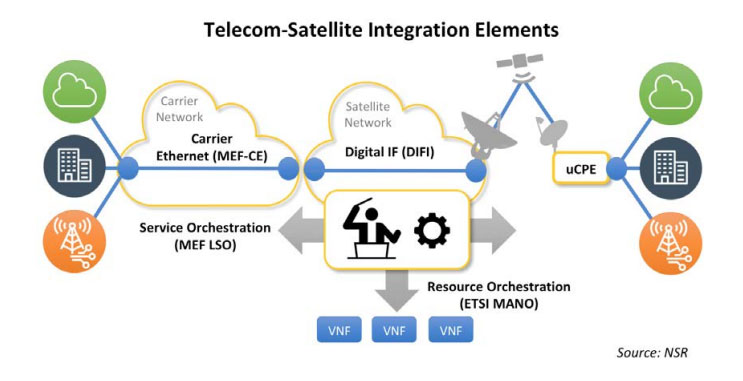
PARIS — The evolution of on-orbit technologies and the integration of satcom with telecom services are beginning to change the perception of the satellite ground system from a purpose-built, legacy infrastructure to a space network enabler.
According to a panel of ground system solution providers at World Satellite Business Week (WSBW) 2022, the ground must follow the space segment and terrestrial telecos toward a future that is digital, flexible and interoperable.
“We’re now in a world where we’re not quite sure, from an operator standpoint, what a given service is going to be and then what infrastructure I need to provide that service,” said President of Space, Training & Cybersecurity at Kratos Phil Carrai. “The more flexibility we build into the infrastructure, I think the better off we are.”
Most satellite payloads built today are either fully or partially software-defined, capable of scaling capacity up or down and switching mission sets on the fly, while legacy ground systems need hours or days to reconfigure. Moreover, today’s hardware-based ground systems can’t make full use of the data capacity available through HTS and VHTS.
“Satellites are becoming much more flexible, much more dynamic than they used to be,” Fredrik Simoens, CTO of ST Engineering iDirect agreed. “But you can only realize the full potential of that new space segment if you have the right ground capabilities.”
That sentiment has been echoed across the industry. During a separate WSBW panel, Guillaume Tanier CEO of Leanspace, a software company focused on the digital transformation of space infrastructure, pointed out how ground capabilities are lagging. “Even if we have the ability to reconfigure fully your satellites…if you cannot do the same on the ground, it’s very hard to actually give data to your customer.”
Making the ground a true gateway to an integrated space and terrestrial network will demand virtualization of traditional hardware components so that they can be linked, managed and orchestrated. And according to Carrai, “If you can digitize as close to the antenna or at the antenna as possible and build [almost] everything else in software….it provides a whole lot of flexibility.”
Integration with Telecom Services
Many leading satcom service providers have established partnerships with terrestrial telecommunications. Given the size of the global telecom market, established players and new space entrants hope to expand those relationships beyond today’s limited services—such as cellular backhaul, trunking and enterprise data—to a broader array of services and applications.
Paul Gaske, EVP of Hughes Network Systems described moving into fiber-optic cable and wireless technologies to establish deeper satcom-telecom integration. “All those things can be melded together into a digital network that provides tremendous performance,” Gaske said, suggesting a network architecture modeled on 5G and Open Radio Access Network (O-RAN).
The satellite industry is behind terrestrial telecom in terms of virtualizing technology and integrating into multi-domain operations. According to a recent NSR whitepaper, that has led to a shrinking footprint for satellites which represent 1% of the roughly $2.7 trillion global telecom market.
 (NSR)
(NSR)
Providers expressed optimism that within the next 5-7 years, digital ground could elevate satellite from a last mile, backhaul service to an equal participant in the broader communications ecosystem. By building into existing terrestrial carrier standards, consumers won’t know if their connection is terrestrial or space based.
Interoperability and Adopting Industry Standards
Several speakers emphasized the importance of satcom providers sharing common standards with terrestrial wireless and mobile carrier networks, particularly if they aim to expand services.
CEO of SpaceBridge Inc. David Gelerman anticipated a near future where teleports adopt existing terrestrial standards to communicate across networks, much like cell phones. “We all should be seamlessly interoperable. And to do it, we can only choose to embrace open standards,” he said, referring specifically to O-RAN, 5G for LEO and the Digital Intermediate Frequency Interoperability (DIFI) standards. Several companies are embracing those standards and a few large players have implemented carrier ethernet standards.
Interoperability protocols for digital IF or RF-over-IP applications have been controversial among some providers. Ultimately, commercial and government consumers could end up pushing providers toward standardization. Gelerman argued that users “will force us to comply with open standards or you will disappear. You will be part of seamless homogeneous network or you will disappear.”
A Digital Transformation Underway
For many operators, the digital transformation is already here. Dr. Vagan Shakhgildian, President of Comtech Satellite Network Technologies Corp., described how the shift to software-as-a-service (SaaS) changed his business over six years. Previously, his company sold racks of equipment to mobile network operators. That segment of Comtech stopped producing hardware and now delivers software to subscribers.
“We’ve gone through this transition and it hasn’t been easy,” Shakhgildian acknowledged. “Obviously a lot of effort came into it, a lot of engineering man hours and man years, sometimes it can feel like man centuries. Obviously, we needed to be incentivized…in order to make that transition.”
Despite the operational advantages and flexibility of digital ground, operators are still weighing the benefits against the sunk cost of existing infrastructure. President of CPI (Communications & Power Industries) Andrew Ivers argued that the transition to the virtual teleport will depend on economic realities.
“There’s a lot of stuff out there that works and is good enough, and that’s going to put the brakes on driving madly into the future,” he advised.
Ivers noted that there will be a lot of new technologies emerging in digital ground in the coming years. “The challenge really is which ones of those have economic benefit and which ones…are the shiny penny to the engineers?”
Explore More:
Podcast: Interoperability, Open Standards and the Next Level of Flexibility
DIFI Advances Digital IF Standards for Ground Interoperability
Technology Advances and Changing Investment Strategies Combine to Spur Space Industry Growth
